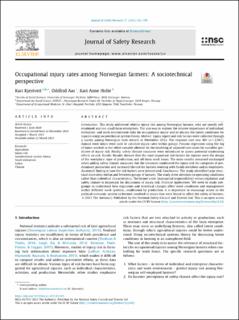| dc.contributor.author | Kjestveit, Kari | |
| dc.contributor.author | Aas, Oddfrid | |
| dc.contributor.author | Holte, Kari Anne | |
| dc.date.accessioned | 2021-10-04T06:30:22Z | |
| dc.date.available | 2021-10-04T06:30:22Z | |
| dc.date.created | 2021-08-16T18:15:43Z | |
| dc.date.issued | 2021 | |
| dc.identifier.citation | Journal of Safety Research. 2021, 77 182-195. | en_US |
| dc.identifier.issn | 0022-4375 | |
| dc.identifier.uri | https://hdl.handle.net/11250/2787303 | |
| dc.description.abstract | Introduction: This study addressed relative injury risk among Norwegian farmers, who are mostly self-employed and run small farm enterprises. The aim was to explore the relative importance of individual, enterprise, and work environment risks for occupational injury and to discuss the latent conditions for injuries using sociotechnical system theory. Method: Injury report and risk factors were collected through a survey among Norwegian farm owners in November 2012. The response rate was 40% (n = 2,967). Annual work hours were used to calculate injury rates within groups. Poisson regression using the log of hours worked as the offset variable allowed for the modeling of adjusted rate ratios for variables predictive of injury risk. Finally, safety climate measures were introduced to assess potential moderating effects on risk. Results: Results showed that the most important risk factors for injuries were the design of the workplace, type of production, and off-farm work hours. The main results remained unchanged when adding safety climate measures, but the measures moderated the injury risk for categories of predominant production and increased the risk for farmers working with family members and/or employees. An overall finding is how the risk factors were interrelated. Conclusions: The study identified large structural diversities within and between groups of farmers. The study drew attention to operating conditions rather than individual characteristics. The farmer’s role (managerial responsibility) versus regulation and safety climate is important for discussions of injury risk. Practical Applications: We need to study sub-groups to understand how regulation and structural changes affect work conditions and management within different work systems, conditioned by production. It is important to encourage actors in the political-economic system to become involved in issues that were found to affect the safety of farmers. | en_US |
| dc.language.iso | eng | en_US |
| dc.rights | Navngivelse 4.0 Internasjonal | * |
| dc.rights.uri | http://creativecommons.org/licenses/by/4.0/deed.no | * |
| dc.title | Occupational injury rates among Norwegian farmers: A sociotechnical perspective | en_US |
| dc.type | Peer reviewed | en_US |
| dc.type | Journal article | en_US |
| dc.rights.holder | © 2021, Authors | |
| dc.description.version | publishedVersion | en_US |
| cristin.ispublished | true | |
| cristin.fulltext | original | |
| cristin.qualitycode | 1 | |
| dc.identifier.doi | 10.1016/j.jsr.2021.03.001 | |
| dc.identifier.cristin | 1926442 | |
| dc.source.journal | Journal of Safety Research | en_US |
| dc.source.volume | 77 | en_US |
| dc.source.pagenumber | 182-195 | en_US |

